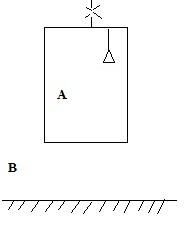The following passage is extracted from the book "Concepts of Physics, Part 1" by H C Verma:
Let us consider the situation shown in figure. An elevator cabin falls down after the cable breaks. The cabin and all the bodies fixed in the cabin are accelerated with respect to the earth and acceleration is about 9.8 $m/s^2$ in the downward direction. Consider the lamp in the cabin. The forces on the lamp are
the gravitational force W by earth and the electromagnetic force T (tension) of the rope. The direction of W is downward and the direction of T is upward. The sum is (W-T) downward. Measure the acceleration of the lamp from the frame of reference of the cabin. The lamp is at rest. The acceleration of the lamp is zero. The person A who measured this acceleration is a learned one and uses Newton's first law to conclude that the sum of the forces acting on the particle is zero, i.e, W-T=0 or, W=T.Instead, if we measure the acceleration from the ground, the lamp has an acceleration of 9.8 $m/s^2$. Thus "a" is not equal to zero and hence the person B who measured this acceleration, concludes from Newton's first law that the sum of the forces is not zero. Thus, W-T is not zero or W is not equal to T. If A measures acceleration and applies the first law he gets W=T. If B measures the acceleration and applies the same first law, he gets W to be not equal to T....

The forces acting on the lamp as seen by B are tension (T) due to string, and gravitational force (W), which gets cancelled. I think there is another force (or acceleration) acting on the lamp (and all other bodies in the cabin), i.e due to acceleration of the cabin itself. So, thread and lamp gets accelerated at the same rate and the tension cancels with W. There seems to be no problem here.
But if we consider what textbook says, i.e with no force due to cabin motion itself and W to be not equal to T, as there are no other force acting, lamp should fall down. But this is not the case, the cabin's thread breaks but not of lamp's.
I am failing to see the mistake, are the textbook statements (in relation with my argument) correct?
